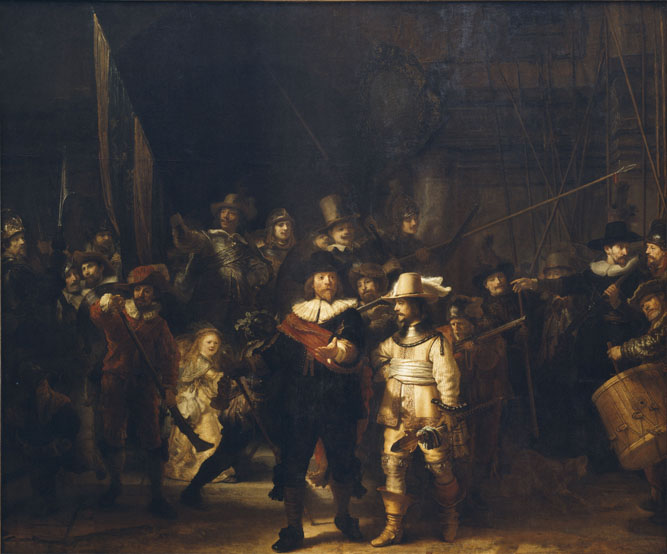Published 20/05/2016
Rembrandt's 17th century masterpiece is in the spotlight, as it takes its place in the newly renovated Rijksmuseum in April 2013. Learn more about the large-scale work.
Also known as, The company of Captain Frans Banning Cocq and Lieutenant Willem van Ruytenburgh, Rembrandt's epic The Night Watch (below) towers over the viewer at approximately 12 feet high x 14 feet wide (cut down from the original at over 13' x 16'). It will retain its previous spot in the Gallery of Honour in Amsterdam's Rijksmuseum, reopening this month. After undergoing a massive decade-long renovation, The Gallery of Honour in the new Rijksmuseum brings together the greatest works of the Dutch Golden Age, including several Vermeers.
Rembrandt is generally considered one of the greatest painters and printmakers of the 17th century, and The Night Watch is arguably his most celebrated work. Originally commissioned by the 18 men in the pictured militia group, the Klouveniers, to adorn one of Amsterdam's civic guard halls, it is particularly notable as Rembrandt was the first to depict the portrait sitters in action. The painting is known for its movement, perspective and its use of light and shade, for which Rembrandt was a master. Standing in front of it, the viewer feels as if they could actually shake Captain Banning's hand, reinforced by its reflection on his lieutenant's costume. Rembrandt was well known for using his wife, Saskia von Uylenburgh, and his son, Titus, as models for his biblical scenes, and the lone woman in The Night Watch bears a striking resemblance to Saskia. Holding the ceremonial drinking horn of the Klouveniers, she functions symbolically as the group mascot.
This painting sits solidly in the Dutch Golden Age, the prolific 17th century period of painting and printmaking that coincided with the new independent Dutch Republic. There was an enormous amount of art produced in this period, by some estimates, several million paintings. Unlike the rest of Europe, religious subjects made up a small percentage of the paintings produced. Dutch Golden Age painting falls into five genres: history & allegory, portraits, genre (scenes of everyday life), landscapes and still life. Click to view some our favorite Dutch Golden Age paintings.
Rembrandt has rightly gotten much press lately, our favorite is this flash mob recreation of The Night Watch in a Dutch shopping mall! In addition, a self-portrait found in an Abbey was recently attributed to the artist and valued at over £20 million.
Rembrandt's other famous works include Danae, Return of the Prodigal Son, The Jewish Bride, Portrait of Jan Six, and our personal favorite, The Anatomy Lesson of Dr. Nicolaes Tulp. Bridgeman has over 500 paintings, prints and drawings by Rembrandt in the archive available for licensing.



